Zoom
Trash

In health care, shared decision-making gains traction. John Hoffmire: Fighting increasing health care costs with reverse innovation. Reverse innovation reverses the direction of innovation flow.
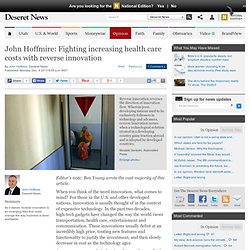
Whereas poor, developing nations used to be exclusively followers in technology and advances, reverse innovation occurs when a technological solution created in a developing country gains traction abroad and is adopted by developed countries. Mustafa Quraishi, Associated Press Enlarge photo» Editor's note: Ben Young wrote the vast majority of this article.
When you think of the word innovation, what comes to mind? One common example is the rise of smartphones. However, with the rise of globalization and greater interaction with developing nations, a new field of innovation has emerged that has the potential to disrupt these trends: reverse innovation. Originally labeled blowback innovation, reverse innovation does just as its name implies: it reverses the direction of innovation flow. Nowhere is this more relevant than health care. John Hoffmire teaches at SaÏd Business School at the University of Oxford. The Dartmouth Center. Home - Normalization Process Theory. Creative Media & Behavioral Health Center » ABOUT. The USC Creative Media & Behavioral Health Center (CM&BHC) is an organized research unit between the School of Cinematic Arts and the Keck School of Medicine.
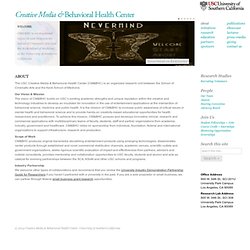
Our Vision & MissionThe vision of CM&BHC builds on USC’s existing academic strengths and unique reputation within the creative and technology industries to develop an incubator for innovation in the use of entertainment applications at the intersection of behavioral science, medicine and public health. It is the mission of CM&BHC to increase public awareness of critical issues in mental health and behavioral science and to provide hands-on creativity-based educational opportunities for health researchers and practitioners. To achieve this mission, CM&BHC pursues and develops innovative clinical, research and commercial applications with multidisciplinary teams of faculty, students, staff and partner organizations from academia, industry, government and healthcare. Tabletsâ Mobility, Connectivity Lead to Adoption by Emergency Managers.
After heavy hail hit 150 homes in Montgomery County, Ky., last March, the county’s emergency management director, Wesley Delk, set out to assess the damage.
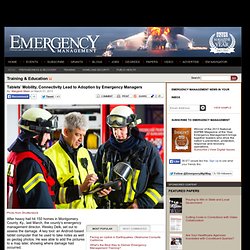
A key tool: an Android-based tablet computer that he used to take notes as well as geotag photos. He was able to add the pictures to a map later, showing where damage had occurred. Delk and his deputy both use tablets for their daily work. “Now it’s engrained into the processes that we do,” he said. But it took about a year from the time Delk first started experimenting with work uses for his personal iPad until it became department policy to issue tablets. Tablet computers are single-panel touchscreen computers that are smaller than a laptop but larger than a phone. Tablets are increasingly being adopted by the emergency management community for everything from note taking to sending warnings from the field. But tablets can have drawbacks, including security concerns and technical limitations.
Expanding Utility Specialized Apps. RePlay Health. The Dartmouth Center. Stop the silent misdiagnosis: patients’ preferences matter. Albert G Mulley, director1, Chris Trimble, adjunct professor1, Glyn Elwyn, visiting professor1 Author Affiliations Correspondence to: G Elwyn elwyng@cardiff.ac.ukAccepted 6 September 2012 Correct treatment recommendations require accurate diagnosis not only of the medical condition but of patients’ treatment preferences.
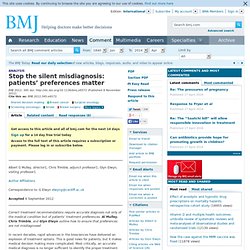
Al Mulley, Chris Trimble, and Glyn Elwyn outline how to ensure that preferences are not misdiagnosed In recent decades, rapid advances in the biosciences have delivered an explosion of treatment options. “Listen to the patient: he is telling you the diagnosis,” William Osler urged students he taught at Johns Hopkins and Oxford more than a century ago. Medicine has changed since Osler’s day, in that there are now more diagnostic technologies and more treatment options. Inconvenient truths about supplier induced demand and unwarranted variation in medical practice. Albert G Mulley, chief12 Author Affiliations amulley@partners.org Doctors need to confront the implications of variation in clinical practice and improve the quality of medical decision making The United States spends 17% of its gross domestic product on health care, the highest of any country, yet does not produce measurably better health.
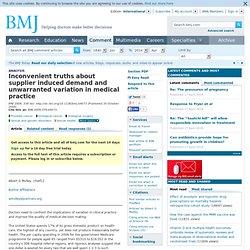
The per capita spending in 2006 for the government Medicare programme for people aged 65 ranged from $5310 to $16 352 in the country’s 306 hospital referral regions, and rigorous analyses suggest that one dollar is wasted for every two that are well spent.1 2 3 Is such variation, and the implied overuse of care in some regions, the result of America’s heavy reliance on market mechanisms and resulting supplier induced demand for services or are there more general lessons for all healthcare economies about the quality of medical decisions?
Rates of common surgical procedures among Medicare patients for 306 … Chris Trimble: why adopting a reverse innovation approach will transform health care. Welcome to the Stella Community. Let's Have Dinner and Talk About Death. OLSON KUNDIG [storefront] / The Making of the Table of TruthDeath Over Dinner.